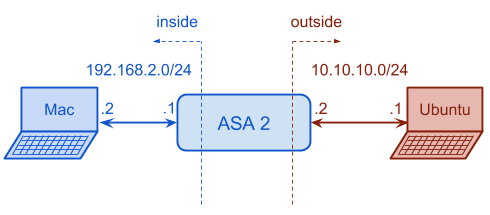Nextelco:ASA basics
Contents
Basic ASA configuration
In this section we will describe how to save ASA's actual configuration, how to erase configuration and how to make the initial configuration.
Save actual configuration
In order to save the actual configuration, we need to connect to ASA through console port and run the following commands.
NexTelCoASA> NexTelCoASA>enable Password: NexTelCoASA#configure terminal NexTelCoASA(config)# NexTelCoASA(config)#copy startup-config disk0: Destination filename [startup-config]?NexTelCoASA_startup-config_20140522 NexTelCoASA(config)#copy running-config disk0: Destination filename [startup-config]?NexTelCoASA_running-config_20140522
These are the necessary steps to save the actual and startup configuration into the device flash disk.
Erase configuration & load the correct boot image
These steps are used to erase the actual configuration and reload the device. Remember that ASA by default starts with the oldest software image.
NexTelCoASA(config)#write erase Erase configuration in flash memory? [confirm] NexTelCoASA(config)#reload System config has been modified. Save? [Y]es/[N]o:N Proceed with reload? [confirm] ... Pre-configure Firewall now through interactive prompts [yes]? No
If in our flash memory we have a newer software version is a good idea to change it.
ciscoasa>enable Password: ciscoasa#configure terminal ciscoasa(config)#boot system disk0:/asa805-k8.bin ciscoasa(config)#asdm image disk0:/asdm-623.bin ciscoasa(config)#write memory ciscoasa(config)#reload Proceed with reload? [confirm]
Initial configuration
In the following Figure we can see which kind of configuration we would like to set up. It is important to remember that inbound ICMP through the ASA is denied by default. Outbound ICMP is permitted, but the incoming reply is denied by default.
Let start with the configuration.
- The first step is to connect though console cable and set up its name, VLANs and interfaces. In order to be able to connect remotely, it is a good recommendation to set up ssh connection.
- The second step is to allow ICMP traffic from inside to outside in order to leave nodes connected to inside network to ping or traceroute the outside networks. There are two different ways to allow ICMP traffic through the ASA:
- ICMP traffic inspection
- This is the simplest way, we just have to and ICMP inspection to the existing inspection_default class of global_policy map.
- Access-lists configuration
- Let start by defining an object-group of type icmp-type in order to classify which of icmp packets will be allowed
- Having an object-group defined now we can create two different access-lists, one for inside interface and the other for outside interface. The inside one will check both IP and ICMP protocols. Since IP communications are stored in a lookup table during some time, it is not necessary to permit them to access the outside interface, this will happen automatically.
- The last step is to apply an access-group on each interface
ASA2(config)#object-group icmp-type ping_traceroute ASA2(config-icmp)#icmp-object echo ASA2(config-icmp)#icmp-object echo-reply ASA2(config-icmp)#icmp-object time-exceeded ASA2(config-icmp)#icmp-object unrechable ASA2(config-icmp)#icmp-object traceroute ASA2(config-icmp)#exit
ASA2(config)#access-list inside_access_in extended permit IP any any ASA2(config)#access-list inside_access_in extended permit icmp any any object-group ping_traceroute ASA2(config)#access-list outside_access_in extended permit icmp any any object-group ping_traceroute
ASA2(config)#access-group inside_access_in in interface inside ASA2(config)#access-group outside_access_in in interface outside
ASA2(config)#policy-map global_policy ASA2(config-pmap)#class inspection_default ASA2(config-pmap-c)#inspect icmp
ciscoasa>enable Password: ciscoasa#configure terminal ciscoasa(config)#hostname ASA2 ASA2(config)#interface vlan 1 ASA2(config)#ip address 192.168.2.1 255.255.255.0 ASA2(config)#nameif inside INFO: Security level for "inside" set to 100 by default. ASA2(config-if)#interface vlan 2 ASA2(config-if)#ip address 10.10.10.2 255.255.255.0 ASA2(config-if)#nameif outside INFO: Security level for "inside" set to 0 by default. ASA2(config-if)#exit ASA2(config)#interface ethernet0/0 ASA2(config-if)#switchport access vlan 2 ASA2(config-if)#no shutdown ASA2(config-if)#exit ASA2(config)#interface ethernet0/1 ASA2(config-if)#no shutdown ASA2(config-if)#exit ASA2(config)#crypto key generate rsa modulus 2048 WARNING: You have a RSA keypair already defined name <Default-RSA-Key>. Do you really want to replace them? [yes/no]: yes Keypair generation process begin. Please wait... ASA2(config)#aaa authentication ssh console LOCAL ASA2(config)#ssh 192.168.2.0 255.255.255.0 inside
Finally, we will be able to ping and access a web page available at Ubuntu from Mac.
Return to Phase 1 page.
